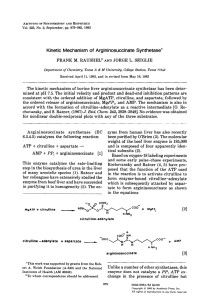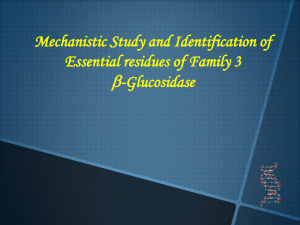6-Enzymatic Rxn Fundamental - Dicky Dermawan
advertisement
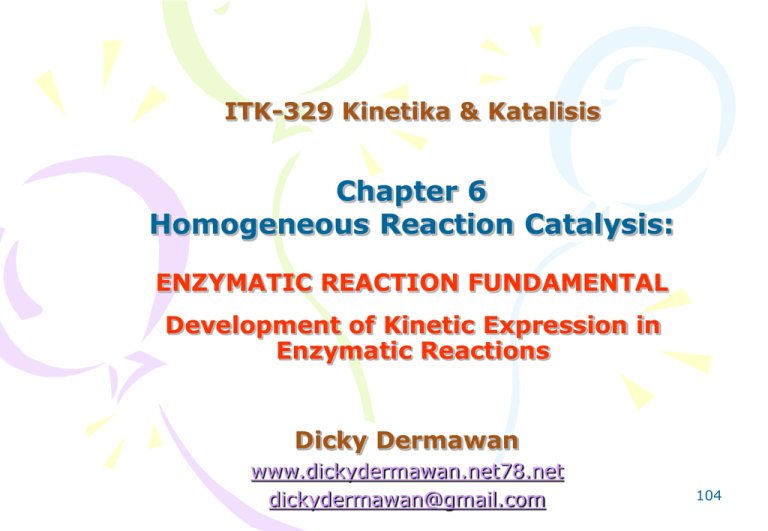
ITK-329 Kinetika & Katalisis Chapter 6 Homogeneous Reaction Catalysis: ENZYMATIC REACTION FUNDAMENTAL Development of Kinetic Expression in Enzymatic Reactions Dicky Dermawan www.dickydermawan.net78.net dickydermawan@gmail.com 104 General Properties of Enzymes # accelerate specific reaction # very selective # work on mild condition k1 E+S (ES)* k2 k3 (ES)* + W P+E W = Solvent, usually water, Considered constant in concentration Example: Urease O NH2CNH2 + Urease O NH2CNH2-Urease O NH2CNH2-Urease O NH2CNH2 + Urease O NH2CNH2-Urease + HOH 2NH3 + CO2 + U 105 Development of Kinetic Expression k1 E+S (ES)* k2 (ES)* + W k3 PSSH : Et rES k1ES k 2 ES k3 ESW 0 [E]t [E] [ES] Enzyme balance: ES O NH2CNH2 W = Pelarut (konstan) P+E [E] [E]t [ES] k1 ([E]t [ES])[S] [ES](k 2 k 3[ W]) k1[S][E]t k1[S][ES] (k 2 k 3[ W])[ES] k1[S][E]t [ES] k1[S] k 2 k 3[ W] rs k1ES k 2 ES k1 k 3 [S][E]t [ W] rs k1[S] k 2 k 3[ W] 106 Michaelis – Menten Equation rp rs rp k 3 [E]t [ W] Michaelis – Menten Equation: where rs rP [S] [S] k 2 k3[ W ] k1 Vmax [S] [S] K m Vmax k 3 [E]t [W] Property at low substrate concentration: [S] <<<< Km rs Property at high substrate concentration: k 2 k 3 [ W] Km k1 Vmax [S] Km First order!!! [S] >>>> Km rs Vmax km Zero order!!! 107 Plot of Michaelis – Menten Equation -rs = rp Vmax 2 Estimating Vmax and KM Burke Lineweaver Plot 1 [S] K m rs Vm ax [S] 1 1 K 1 m . rs Vm ax Vm ax [S] Alternatively, Eadie plot can be constructed Km [S] 1 rs 1 Vm ax tan Km Vmax 1 [S ] 108 Example : 7-7 Determine the Michaelis – Menten Parameters for the reaction: k 1 k 3 , H 2O urea urease [urea urease] * 2 NH3 CO 2 urease k 2 The rate of reaction is given as a function if urea concentration in the following table Curea [kmol/m3] -rurea [kmol/m3/s] 0.2 0.02 0.02 0.005 0.002 1.08 0.55 0.38 0.2 0.09 Use: a. Burke – lineweaver plot b. Eadie plot Compare the results and determine which method fits better 109 P7-11B Beef liver catalase has been used to accelerate the decomposition of hydrogen peroxide to yield water and oxygen. The concentration of hydrogen peroxide is given as a function of time for a reaction mixture with pH of 6.76 and maintain at 30oC, (a) (b) t (min) 0 10 20 50 100 C H2O2 (mol/liter) 0.02 0.01775 0.0158 0.0106 0.005 Determine the Michaelis-Menten parameters Vmax and Km If the total enzyme concentration is tripled, what will the substrate concentration be after 20 min ? 110 Integration of Rate Equation Ex. 7-8 Calculate the time needed to convert 80% of the ure xammonia and carbon dioxide in a 0.5 L batch reactor. The initial concentration of urea is 0.1 mol/L, and the urease concentration is 0.001 g/L. The reaction is to be carried out isothermally. At this temperature, if total enzyme concentration used is 5 g/L: rs Ex. 7-8 1.33 [S] mol 0.0266 [S] L.s If the reaction is carried out in 15 minutes using enzyme 111 concentration of 0.0002 g/L, what will be the conversion? P7-10C Integration of Rate Equation 112 Enzymatic Reaction Inhibition In addition to pH, another factor that greatly influences the rates of enzyme-catalyzed reactions is the presence of an inhibitor. The most dramatic consequences of enzyme inhibition are found in living organisms, where the inhibition of any particular enzyme involved in a primary metabolic sequence will render the entire sequence inoperative, resulting in either serious damage or death of the organism. For example, the inhibition of a single enzyme, cytochrome oxidase, by cyanide will cause the aerobic oxidation process to stop; death occurs in a very few minutes. There are also beneficial inhibitors such as the ones used in the treatment of leukemia and other neoplastic diseases. 113 Enzymatic Reaction Inhibition The three most common types of reversible inhibition occurring in enzymatic reactions are competitive, uncompetitive, and noncompetitive. The enzyme molecule is analogous to the heterogeneous catalytic surface in that it contains active sites. When competitive inhibition occurs, the substrate and inhibitor are usually similar molecules that compete for the same site on the enzyme. Uncompetitive inhibition occurs when the inhibitor deactivates the enzyme-substrate complex, usually by attaching itself to both the substrate and enzyme molecules of the complex. Noncompetitive inhibition occurs with enzymes containing at least two different types of sites. The inhibitor attaches only to one type of site and the substrate only to the other. 114 Enzymatic Reaction Inhibition: Competitive Inhibition Competitive inhibition is of particular importance in pharmacokinetics (drug therapy). If a patient were administered two or more drugs simultaneously which react within the body with a common enzyme, cofactor, or active species, this could lead to competitive inhibition of the formation of the respective metabolites and produce serious consequences. In this type of inhibition another substance, I, competes with the substrate for the enzyme molecules to form an inhibitorenzyme complex, (E I). k 1 Mechanism: S+E ES k2 k3 I+E EI k4 ES k5 P+E 115 Competitive Inhibition k1 Mechanism: S+E I = Inhibitor = Penghambat laju reaksi ES k2 k3 I+E EI k4 ES k5 P+E d[ES] PSSH : 0 k1 [S] [E] k 2 [SE] k 5 [SE] dt d[EI ] PSSH : 0 k 3 [I] [E] k 4 [EI ] dt k1 [S] [E] k 2 k5 k [EI] 3 [I] [E] k4 [ES] Enzyme balance: [E]t [E] [EI] [ES] [E]t [E] k3 k [E] [S] [I] [E] 1 k4 k 2 k5 [ E ]t [E] 1 k3 k1 [I] 116 [S] k4 k 2 k5 Competitive Inhibition (cont’) k1 Mechanism: S+E SE k2 k3 I+E EI k4 rp k 5 [ES] rp k 5 ; substituting expression for [ES]: ES KM k 5 [S] [E]t k 2 k5 k 2 k5 k3 [I] [S] k4 k1 k1 k 2 k5 k1 P+E k1 [S] [E] ; substituting expression for [E]: k 2 k5 k 5 k1 [S] [E]t [ E ]t k 5 k1 [S] k 2 k5 1 k 3 [I] k1 [S] (k k ) (k k ) k 3 [I] k [S] 1 5 2 5 2 k 4 k4 k 2 k5 rp k5 rp k 5 [E]t [S] k K M K M 3 [I] [S] k4 k : 1 k1 117 Competitive Inhibition (cont’) k1 Mechanism: k Ki 4 k3 k 5 [E]t [S] rp k K M K M 3 [I] [S] k4 rp k 5 [E]t [S] [ I] KM KM [S] KI S+E k2 k3 I+E Vmax [S] [ I] [S] K M 1 K I Vmax k5 [E]t EI k4 SE rp SE k5 rp Vmax P+E [S] K M ' [S] [ I] K M ' K M 1 KI …… Jika penambahan suatu zat I ke dalam kultur menyebabkan kenaikan harga KM tanpa perubahan harga Vmax, maka I menginhibisi secara kompetitif. 118 Enzymatic Reaction Inhibition: Uncompetitive Inhibition Here, the inhibitor does not compete with the substrate for the enzyme; instead, it ties up the enzymesubstrate complex by forming an inhibitor-enzymesubstrate complex, thereby restricting the breakdown of the (E S) complex to produce the desired product. Mechanism: S + E k1 ES k2 k3 I + ES EIS k4 ES k5 P+E 119 Uncompetitive Inhibition k1 Mechanism: S + E ES k2 k3 I + ES ES k4 k5 EIS P+E d[ES] P SSH : 0 k1 [S] [E] k 2 [ES] k 3 [ES] [I] k 4 [EIS] k 5 [ES] dt k1 [S] [E] k 3 [I] [ES] k1 [S] [E] k 4 [EIS] [ ES ] [ES] k 2 k 3 [ I] k 5 k 2 k 3 [ I] k 5 P SSH : d[EIS] 0 k 3 [I] [ES] k 4 [EIS] dt k [EIS] 3 [I] [ES] k4 [ES] k1 [S] [E] k 2 k5 [ES] k 3 [ I] k1 [S] [E] [ES] k 2 k 3 [ I] k 5 k 2 k 3 [ I] k 5 k 3 [ I] k1 [S] [E] 1 [ES] k 2 k 3 [ I] k 5 k 2 k 3 [ I] k 5 k 2 k5 k1 [S] [E] [ES] k 2 k 3 [ I] k 5 k 2 k 3 [ I] k 5 120 Uncompetitive Inhibition (cont’) Mechanism: S + E Enzyme balance: [E] t [E] ES k2 [E ] t [E ] [ES] [EIS] [E] t [E] k1 k3 I + ES k k1 [S] [E ] 3 [I] [ES] k 2 k5 k4 EIS k4 ES k5 P+E k1 k k1 [S] [E ] 3 [I] [S] [E ] k 2 k5 k4 k 2 k5 k1 k k 3 1 [E ] t [E ] 1 [S] [I] [S] k 2 k5 k4 k 2 k5 [ E] [ E ]t k1 k k1 [S] 1 [S] 3 [I] k 2 k5 k4 k k 5 2 k1 [ES] [S] [E] k 2 k5 [ES] k1 [S] k 2 k5 [ E ]t k1 k k1 121 1 [S] 3 [I] [S] k 2 k5 k4 k 2 k5 Uncompetitive Inhibition (cont’) k1 [ES] [S] k 2 k5 [ E ]t k1 k3 k1 [S] 1 [S] [I] k 2 k5 k4 k 2 k5 k1 [S] [E]t [ES] k 2 k 5 k1 [S] k 3 [I] k1 [S] k4 [S] [E]t [ES] k 2 k5 k [S] 3 [I] [S] k4 k1 [ES] [ES] Mechanism: S + E k1 ES k2 k3 I + ES k : 1 k1 ES Ki k4 k3 k4 k5 KM EIS P+E k 2 k5 k1 [S] [E]t [ I] K M [S] [S] Ki [E ]t [S] [ I] K M [S] 1 K i 122 Uncompetitive Inhibition (cont’) Mechanism: S + E k1 ES k2 Ki Finally: k4 k3 rp k 5 [E] rp k 5 rp I + ES ES [E]t [S] [ I] K M [S] 1 Ki Vmax [S] [ I] K M [S] 1 Ki k3 Vmax k5 [E]t Vmax [S] KM [ I] [S] 1 K i 1 [I] K i V "[S] max K M " [S] rp rp Inhibisi uncompetitive mengakibatkan penurunan harga Vmax dan KM secara bersama-sama EIS k4 k5 P+E KM Vm ax" Km" k 2 k5 k1 Vm ax [ I] 1 Ki Km [ I] 1 K i 123 Non Competitive Inhibition In noncompetitive inhibition, the substrate and inhibitor molecules react with different types of sites on the enzyme molecule, and consequently, the deactivating complex, IES, can be formed by two reversible reaction paths: 1. After a substrate molecule attaches to the enzyme molecule at the substrate site, the inhibitor molecule attaches to the enzyme at the inhibitor site. 2. After an inhibitor molecule attaches to the enzyme molecule at the inhibitor site, the substrate molecule attaches to the enzyme at the substrate site. Mechanism: k1 S+E ES k2 k3 I+E EI k4 k5 EI + S EIS k6 k7 ES + I EIS k8 ES k9 P+E 124 Non Competitive Inhibition (cont’) Use “rate limiting” concept assuming reaction (5) as rate limiting step: rp k9 [ES] Other reactions are in equilibrium with equilibrium constant of KS, KI, KS’ and KI’ for reaction (1) to (4), respectively. Mechanism: k1 S+E ES k2 k3 I+E EI k4 k5 EI + S EIS k6 k7 ES + I EIS k8 ES k9 k1 [S] [E] k 2 [ES] [ES] KS [S] [E] k3 [I] [E] k 4 [EI] [EI] KI [I] [E] k5 [EI] [S] k 6 [EIS] [EIS] KS ' KI [I] [E] [S] k 7 [ES] [I] k8 [EIS] [EIS] KI ' KS [I] [E] [S] P+E Further, assume KS= KS’ and KI = KI’ to obtain: rp Vmax [S] [ I] (S K m ) 1 Ki KM 1 1 ; Ki KS KI 125 Non Competitive Inhibition (cont’) Further, assume KS= KS’ and KI = KI’ to obtain: Enzyme balance: [E] t [E] [ES] [EI] [EIS] [E] t [E] KS [S] [E] K i [I] [E] KS K i [I] [E] [S] [ E ]t [E] 1 KS [S] K i [I] KS K i [S] [I] Mechanism: From rp k9 [ES] use KM k1 S+E ES k2 k3 I+E EI k4 k5 EI + S 1 1 ; Ki KS KI EIS k6 k7 ES + I EIS k8 ES k9 P+E to obtain: rp Vmax [S] [ I] (S K m ) 1 Ki 126 Enzymatic Reaction Inhibition: Comparison & Summary a. Competitive Inhibition S+E I+E k1 k2 k3 k4 k5 ES c. Non Competitive Inhibition k1 ES S+E ES k2 k3 EI P+E I+E EI k4 k5 EI + S EIS k6 k7 b. Uncompetitive Inhibition ES + I k8 k1 S+E ES k2 EIS ES k9 P+E k3 I + ES ES k4 k5 EIS 127 P+E Enzymatic Reaction Inhibition: Comparison & Summary No Inhibition Competitive Inhibition Uncompetitive Inhibition Noncompetitive Inhibition Vmax [S] [S] K m rp rp VMax [S] [ I] [S] K m 1 Ki rp KM rp Vmax [S] [ I] [S] 1 Ki Vmax [S] [ I] (S K m ) 1 K i 128 Enzymatic Reaction Inhibition: Comparison in Plot Burke – Lineweaver Eadie (a) ? (b) ? (c) ? 129 P7-14B 130 Special Case: Inhibisi oleh Substrat Mechanism: k1 S+E SE k2 k3 S + ES SE k4 k5 SES P+E d[ES] k [S] [E] k 4 [SES] k1 [S] [E] k 2 [SE ] k 3 [S] [ES] k 4 [SES] [ES] 1 dt k 2 k 5 k 3 [S] d[SES] k 3 [S] [ES] k 4 [SES] dt [SES] k3 [S] [ES] k4 131 Inhibisi oleh Substrat (cont’) k k1 [S] [E] k 4 3 [S] [ES] k4 [ES] k 2 k 5 k 3 [S] [ES] k 3 [S] [ES] k [S] [E] 1 k 2 k 5 k 3 [S] k 2 k 5 k 3[S] Enzyme balance: [ES] k1 [S] [E] k 2 k5 [E ]t [E] [ES] [SES] [E] k1 k k1 [S] [E] 3 [S] [S] [E] k 2 k5 k4 k 2 k5 [ E ]t [E] 1 k1 k k1 [S] 3 [S] [S] k 2 k5 k4 k 2 k5 132 Inhibisi oleh Substrat (cont’) rp k 5 [ES] [ E ]t k1 [S] k5 k 2 k5 1 k1 [S] k 3 [S] k1 [S] k k k 2 k5 k 4 2 5 k 5 k1 [S] [E]t k (k 2 k 5 ) k1 [S] 3 [S] k1 [S] k4 k 5 [E]t [S] rP k3 k 2 k5 [S] [S] 2 k4 k1 rs Vmax [S] [S] K m [S] 1 Ki 133 Curve Fittings: Substrate-inhibited Enzymatic Reaction Perkirakan harga Vmax, KM, dan Ki berdasarkan plot hasil percobaan dari reaksi enzimatik yang diinhibisi substrat di bawah ini. 134
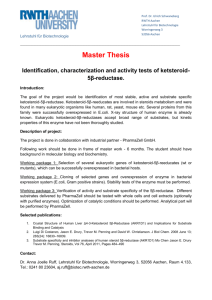
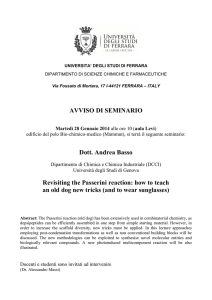
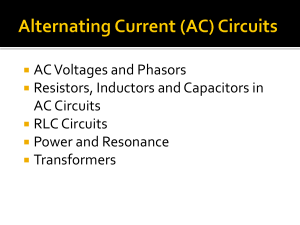
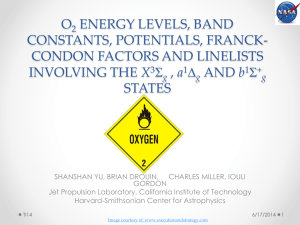


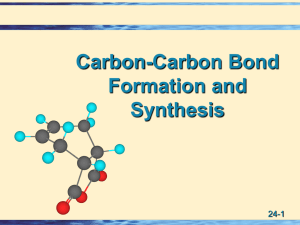
![[A] t - Dr. Agus Setiabudi, M.Si.](http://s2.studylib.net/store/data/005634279_1-eed3e2d8492eb37cb8d8ed06da0883dc-300x300.png)
